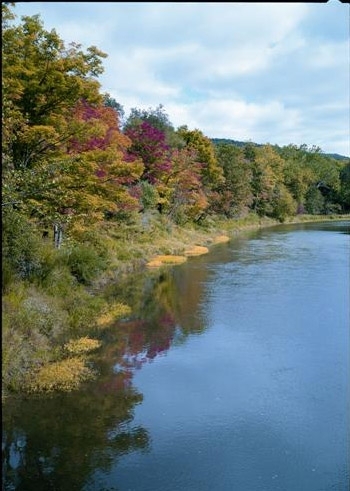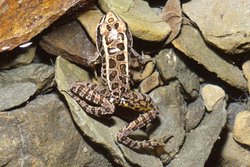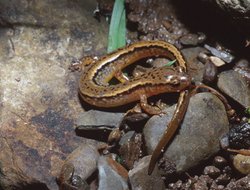Allegheny Highlands forests
ContentsWWF Terrestrial Ecoregions Collection |
Introduction
The presettlement forests of the Allegheny Highlands consisted primarily of hemlock (Tsuga canadensis) and beech (Fagus grandifolia)—together the two species represent nearly 60 percent of all the trees observed in early land surveys of what is now Allegheny National Forest. Although hemlock and beech tolerate shade, the occurrence of both species can be traced to periodic catastrophes, particularly fire. Sugar maple (Acer saccharum), an associate of the beech-hemlock type, often replaced hemlock as the major component of presettlement forests. Beech-maple stands were more common on less-moist sites, perhaps because fire had eliminated hemlock. Red maple (Acer rubrum), yellow and black birch (Picea glauca and P. mariana), white ash (Fraxinus americana), and black cherry (Prunus seratina) were common associates in both the hemlock-beech and beech-maple forests. White pine occurred in well-defined, relatively pure stands. These stands generally originated after fires or windthrow wiped out the preceding stands. Between 1890 and 1920, loggers cleared most of the Allegheny Plateau. Save for a few pockets of old growth, the current forests, which contain most of the presettlement species in different relative abundances and distribution, originated at that time. The heavy cutting favored hardwoods and created massive amounts of coniferous slash, providing ideal conditions for widespread and intense fires. The fires were a major factor in the virtual elimination of white pine and hemlock in the Allegheny forests. Repeated fires also tended to reduce the proportion of sugar maple, beech, and other typical hardwoods and increase such species as aspen, pin cherry, sedges, grasses, and honeysuckles. These forests display large-scale patterning related to soil drainage, which segregates areas dominated by beech, hemlock, and white pine from areas dominated by hemlock and yellow birch. Smaller-scale patterning separates small areas of hemlock from yellow birch. An expanding deer population plays an important role in these forests, particularly in old growth areas. Heavy deer browsing since the 1930s has had a profound influence on the size-class distribution of stems. In one stand, for example, by 1978 deer had eliminated the smaller classes of once-common trees other than beech. WWF (Allegheny Highlands forests)
Biological Distinctiveness
The Finger Lakes and Pocono Mountains are biologically important areas. The Finger Lakes contain a mixture of northern and southern species, and the deeply cut lakes reveal remarkable geological strata. The Pine Barrens in the Poconos are a unique formation.
Conservation Status
Habitat Loss
Less than one percent of this ecoregion remains intact, but once logged areas are now reforested. Agriculture, particularly in the western and central lowlands, is the leading cause of habitat loss, while recreation and development contribute to habitat loss in the northern parts of the ecoregion.
Remaining Blocks of Intact Habitat
Relatively few large habitat blocks remain. The most important blocks are:
- Pennsylvania State Forest, Potter/Clinton Counties – north-central Pennsylvania – approximately 1,000 square kilometers (km2);
- Allegheny National Forest, McKean/Warren Counties – northwestern Pennsylvania – 16.2 km2 (4,000 acres);
- Catskill State Park – central New York (65 km2 unlogged in one tract; total unlogged is 54,000-65,000 km2 in 38 tracts);
- Allegany State Park – western New York.
Degree of Fragmentation
The forests of the Allegheny Highlands are moderately fragmented, with some connectivity, clusters of habitat fragments, and an intervening landscape that allows for dispersal of many taxa through some parts of the ecoregion.
Degree of Protection
This ecoregion contains no protected areas larger than 500 square kilometers (km2. The most important protected areas are:
- Hammersley Fork Wilderness Area (approx. 100 km2);
- Cook State Forests – northwestern Pennsylvania – 6.1 unlogged km2 (1,500 acres) in a 29.1 km2 (7,200 acre) forest;
- Catskills – 219-263 km2 (54,000-65,000 acres) of mostly state land;
- Long Pond Macrosite – 24.3 km2 (6,000 acres) under mixed ownership, including TNC;
- Arbutus Peak Oak Barren Macrosite, Luzerne County – northeastern Pennsylvania – 21.5 km2 (5,313 acres) owned by the Pennsylvania Game Commission;
- Lehigh Pond, Wayne County – northeastern Pennsylvania – 15.8 km2 (3,912 acres);
- Hemlock Lake and Canadise Lake – western New York – approximately 4 km2 (1,000 acres);
- Bergen Swamp – approximately 8 km2 (2,000 acres);
- Allegheny National Forest – northwestern Pennsylvania;
- Allegany State Park – western New York – includes 2.8 km2 (700 acres) of old growth;
- Woodbourne Forest – includes 2.4 km2 (600 acres) of old growth and second growth forest.
Types and Severity of Threats
Recreational and suburban development pose a significant threat to the forests of the Allegheny Highlands, particularly in the Finger Lakes region and the Catskills. In the western portion of the ecoregion, a booming deer population is destroying herbaceous vegetation and preventing tree regeneration.
Suite of Priority Activities to Enhance Biodiversity Conservation
The decline in agriculture in much of this ecoregion presents an opportunity for conservation. A top priority should be either to acquire land taken out of production or improve the management of that land. Key sites include the Finger Lakes, Poconos, and French Creek, a pristine river valley in southwest New York and northwest Pennsylvania that harbors diverse flora and fauna. Deer must be controlled throughout the ecoregion and especially in Allegheny National Forest and the Catskills.
Conservation Partners
- New York Natural Heritage Program
- Pennsylvania Natural Diversity Inventory – Central Bureau of Forestry
- Pennsylvania Natural Diversity Inventory – East
- Pennsylvania Natural Diversity Inventory – West
- The Nature Conservancy of Pennsylvania
- The Nature Conservancy, Central and Western New York Chapter
- The Nature Conservancy, Central/Western Office
- Western Pennsylvania Conservancy
Relationship to other classification schemes
The Allegheny Highland Forests are demarcated from surrounding hardwood forests by elevation. Omernik divides the region in four parts: the Northern Appalachian Plateau and Upland; the North Central Appalachians; the Western Allegheny Plateau; and the Erie/Ontario Lake Plain. We believe the communities here are similar enough to warrant classification into a single ecoregion, which is still not so large as to be unmanageable.
Additional information on this ecoregion
- For a shorter summary of this entry, see the WWF WildWorld profile of this ecoregion.
- To see the species that live in this ecoregion, including images and threat levels, see the WWF Wildfinder description of this ecoregion.
- World Wildlife Fund Homepage
| Disclaimer: This article is taken wholly from, or contains information that was originally published by, the World Wildlife Fund. Topic editors and authors for the Encyclopedia of Earth may have edited its content or added new information. The use of information from the World Wildlife Fund should not be construed as support for or endorsement by that organization for any new information added by EoE personnel, or for any editing of the original content. |


